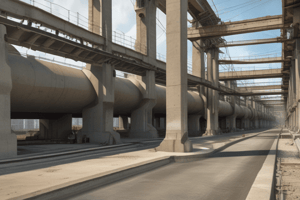Podcast
Questions and Answers
What distinguishes a pre-stressed concrete structure from a conventional reinforced concrete structure?
What distinguishes a pre-stressed concrete structure from a conventional reinforced concrete structure?
- Higher water-cement ratio in the mix
- Application of an initial load prior to use (correct)
- Use of low-strength steel reinforcements
- Use of lightweight aggregates
Which of the following is a consequence of cracking in the tensile region of concrete?
Which of the following is a consequence of cracking in the tensile region of concrete?
- Increased tensile strength of the material
- Decrease in shear capacity
- Higher external load required to crack
- Significant loss of stiffness after cracking (correct)
What effect does pre-compression have on concrete structures?
What effect does pre-compression have on concrete structures?
- Decreases overall weight of the structure
- Reduces the flexibility of the concrete
- Increases the external load required for cracking (correct)
- Eliminates the need for any reinforcing steel
Which characteristic of concrete makes it susceptible to cracking under tension?
Which characteristic of concrete makes it susceptible to cracking under tension?
What is one of the primary goals of using pre-stressed concrete?
What is one of the primary goals of using pre-stressed concrete?
How does pre-stressed concrete improve flexural capacity in columns?
How does pre-stressed concrete improve flexural capacity in columns?
One of the advantages of pre-stressing in concrete is:
One of the advantages of pre-stressing in concrete is:
What is a potential durability issue in reinforced concrete when excessive cracking occurs?
What is a potential durability issue in reinforced concrete when excessive cracking occurs?
What does excessive deflection in concrete structures typically indicate?
What does excessive deflection in concrete structures typically indicate?
Which factor is primarily controlled or eliminated through the use of pre-stressing?
Which factor is primarily controlled or eliminated through the use of pre-stressing?
Study Notes
Introduction to Prestressed Concrete Design
- Prestressed concrete structures apply an initial load before use, distinguishing them from conventional reinforced concrete.
- The technique aims to combat the inherent weakness of concrete in tension, addressing issues like cracking and excessive deflection.
Challenges in Conventional Concrete
- Conventional concrete experiences tensile cracking, leading to reduced stiffness and potential durability problems.
- High-strength steel is often underutilized in standard reinforced concrete applications.
Benefits of Prestressing
- Prestressing introduces pre-compression, which significantly increases the load required for cracking, enhancing overall strength and stiffness.
- It allows for better control or elimination of tensile stresses, reducing the risk of cracking under service load levels.
Performance Enhancements
- Helps to control deflection at predetermined load levels, ensuring structural integrity.
- Facilitates the effective use of high-strength steel and high-strength concrete, optimizing material benefits.
Shear and Flexural Capacity
- Prestressed concrete exhibits higher shear capacity than conventional reinforced concrete.
- This method can also improve flexural capacity in columns, particularly in typical design regions.
Studying That Suits You
Use AI to generate personalized quizzes and flashcards to suit your learning preferences.
Related Documents
Description
This quiz covers Lesson 1 of CE 414, focusing on the fundamentals of Prestressed Concrete Design. Students will learn about the key concepts and design principles that are essential for understanding prestressed concrete structures. Prepare to test your knowledge on this critical aspect of civil engineering!




